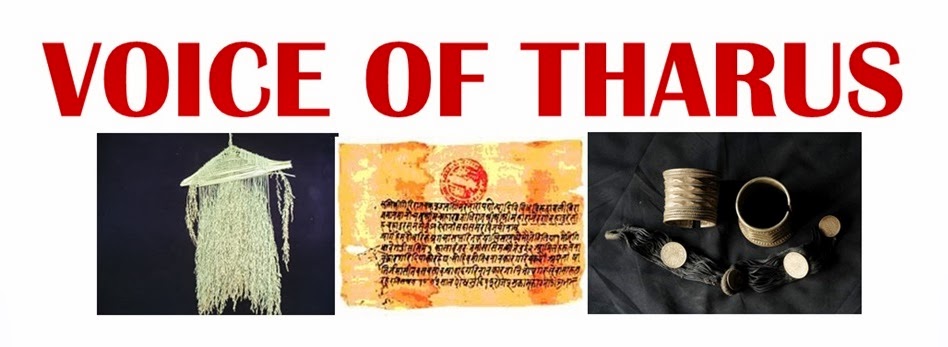An outsider will probably be amazed to see the black and white dots and circles painted on an earthen pot hanging to a tree. If you visit the Terai and take a tour of villages, you will find lot many winnowing trays woven from bamboo culms and broken clay pots – bearing black and white dots and circles – resembling the eye and iris. They are either hung to a fruiting tree or kept among the growing vegetables in the fields, kitchen garden and thatched roofs.
Surrounded by superstitions
The Terai is surrounded by superstitions. Ridiculous practices like using a water snail smeared with vermilion to harm others (by witches), avoiding sneezing while leaving a place, not asking someone directly where s/he is going, hanging the snake moult skin on the door, hanging horse-shoe at the entrance, travelling westwards only on Tuesdays and Saturdays and so on are widely popular here.
Among the stack of superstitions, people in Terai hang the winnowing trays or broken clay pots with black and white dots and circles to ward off the evils or bad luck caused by the envious or ill-wishing looks. These days it has become a common practice among the people to safeguard their vegetables and fruits from the envious eyes.
The black and white dots and circles represent the eye and iris. They are called “Dain Jogin” meaning the witch and hermit. People here believe that the evil eyes save the bearer (fruit trees and vegetables) from the ill-wishing looks of witches and envious people.
Practised widely around the world
The practice of hanging evil eyes is not only limited to the Terai of Nepal. The evil eye is believed by many cultures around the world to be able to cause injury or bad luck for the person at whom it is directed for reasons of envy or dislike. The term also refers to the power attributed to certain persons of inflicting injury or bad luck by such an envious or ill-wishing look.
The evil eye belief exists in India, Spain, Portugal, Turkey, Greece, Scandinavian countries, Britain, North Africa and many other countries. The indigenous people in Latin America also believe in evil eyes and the belief has also extended to North America, Australia and New Zealand.
When I asked an old Tharu lady about the evil eyes, she just smiled, “It’s been practised since ages and if I stop putting the dain jogin who will take care of the envious eyes harming the growth and fruition of my vegetables and fruits?”
However, the evil eyes are a visual delight to someone from outside. And of course it frightens away the little birds and crows which come to peck at the buds, flowers, young fruits and vegetables. So, next time you are in the Terai look for the evil eyes hung to the fruit trees and vegetable gardens!
Surrounded by superstitions
The Terai is surrounded by superstitions. Ridiculous practices like using a water snail smeared with vermilion to harm others (by witches), avoiding sneezing while leaving a place, not asking someone directly where s/he is going, hanging the snake moult skin on the door, hanging horse-shoe at the entrance, travelling westwards only on Tuesdays and Saturdays and so on are widely popular here.
Among the stack of superstitions, people in Terai hang the winnowing trays or broken clay pots with black and white dots and circles to ward off the evils or bad luck caused by the envious or ill-wishing looks. These days it has become a common practice among the people to safeguard their vegetables and fruits from the envious eyes.
The black and white dots and circles represent the eye and iris. They are called “Dain Jogin” meaning the witch and hermit. People here believe that the evil eyes save the bearer (fruit trees and vegetables) from the ill-wishing looks of witches and envious people.
Practised widely around the world
The practice of hanging evil eyes is not only limited to the Terai of Nepal. The evil eye is believed by many cultures around the world to be able to cause injury or bad luck for the person at whom it is directed for reasons of envy or dislike. The term also refers to the power attributed to certain persons of inflicting injury or bad luck by such an envious or ill-wishing look.
The evil eye belief exists in India, Spain, Portugal, Turkey, Greece, Scandinavian countries, Britain, North Africa and many other countries. The indigenous people in Latin America also believe in evil eyes and the belief has also extended to North America, Australia and New Zealand.
When I asked an old Tharu lady about the evil eyes, she just smiled, “It’s been practised since ages and if I stop putting the dain jogin who will take care of the envious eyes harming the growth and fruition of my vegetables and fruits?”
However, the evil eyes are a visual delight to someone from outside. And of course it frightens away the little birds and crows which come to peck at the buds, flowers, young fruits and vegetables. So, next time you are in the Terai look for the evil eyes hung to the fruit trees and vegetable gardens!
















